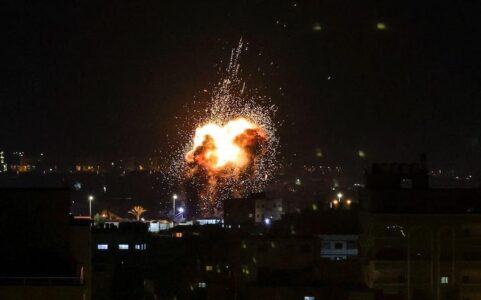
Recent rocket attacks represent the IRGC’s Palestinian face
Once again, as it did in 2021, the integrated network known as the Islamic Revolutionary Guard Corps (IRGC) chose to piggyback on tensions and provocations in Jerusalem to launch salvoes of rockets at Israel from Lebanon, Gaza and Syria. And once again, the majority of the commentariat has missed the Iranian role entirely and fallen for the narrative that these rockets were part of the Israeli-Palestinian conflict.
This is far from the first time the Palestinian fronts of the IRGC’s “resistance axis” have fired rockets from Lebanon, hence Israel striking Palestinian bases there in 2013 and 2019. Rockets were also launched, likely by Palestinians, in 2009 from Lebanon. While at least the 2013 and 2019 incidents were attributed to the Popular Front for the Liberation of Palestine-General Command (PFLP-GC), the recent salvo from Lebanon was far larger and blamed on Hamas (the Syrian rockets during this round were attributed to another Palestinian front group known as the “Al-Quds Brigade”).
Israel first publicly complained that the IRGC was setting up Hamas infrastructure in Lebanon for such attacks in June 2018. Hamas activity in the country dates back to at least the early 1990s, when Israel deported Hamas members and other Palestinian terrorist leaders to Hezbollah-controlled Lebanon, and Hezbollah then enabled attacks from Lebanon and in the West Bank and Gaza by Palestinians during the Second Intifada. The Palestinian refugee camps in Lebanon have always been major recruiting ground for all terrorist groups since at least the 1960s, and it should come as no surprise that Hamas has a strong presence in the country. Hamas deputy leader, terrorism overseer and key IRGC liaison Saleh al-Arouri is a Lebanese national and reportedly divides his time between Lebanon and Qatar, although he may still reside in Turkey.
Both Hamas and the Iranian regime consider the Palestinian terrorist group to be a constitutive element of the IRGC’s regional jihad to destroy Israel. As I wrote in 2021:
Just how integrated the Palestinian groups are in [Iranian Supreme Leader Ali] Khamenei’s transnational jihad was made eminently clear during the May 2021 Gaza war by Hamas’s open gratitude to the supreme leader and the IRGC front groups from Iraq to Yemen, as well as reports of coordinating attacks on Israel. Khamenei himself makes no distinction between Hamas’s leadership and that of the Iraqi Popular Mobilization Forces, PIJ, Hezbollah, and the IRGC itself when discussing the network’s martyrs. So much so that during a press conference by IRGC Aerospace Forces commander Ali Hajizadeh, Hamas’s flag was included among those of its other fronts. Soleimani is reported to have referred to Hamas and PIJ [Palestinian Islamic Jihad] as two of Iran’s external “armies” in the region.
As if to underline the point, the rockets last week were launched while Hamas politburo leader Ismail Haniyeh, leading a senior Hamas delegation, was meeting with Hezbollah Secretary General Hassan Nasrallah in Beirut to “coordinate positions and strengthen the resistance against the Israeli enemy.”
It is very important not to fall for the IRGC’s shell game. All of these ostensibly separate organisations, Palestinian or otherwise, are both materially and, in almost all cases – though not necessarily in the case of Hamas – ideologically beholden to Iran’s Supreme Leader and the IRGC. Hamas and other Palestinian groups simply provide an additional layer to this shell game, providing deniability for Hezbollah, itself a front group acting as the “deniable” Lebanese branch of the IRGC. For the time being, both Israel and its Arab allies have their reasons for preferring to play this game with Iran, rhetorically blaming the regime for attacks by its various local organs, but never hitting IRGC targets in Iran directly out of fear of uncontrollable escalation.
Lebanon is where the Palestine Liberation Organisation (PLO) helped create what would become the IRGC in the 1970s, including Hezbollah, and in turn where the IRGC essentially absorbed the Palestinian terrorist groups a decade or so later, with assistance from Iran’s client state Syria. Unlike in Gaza, where an Egyptian-Israeli blockade generally prevents the most sophisticated weapons from getting through to Hamas, at least in substantial quantities, Lebanon allows for the transfer of far more sophisticated and dangerous missiles and munitions to Hamas, something a US official alleges has already happened.
Israeli military planners will be searching for ways to make it clear to Hezbollah and the rest of the IRGC that the IDF will not continue to play the shell game if there is a launch of anything more sophisticated than the katyushas and other jerry-rigged rockets Hamas fired recently.
Source » aijac





